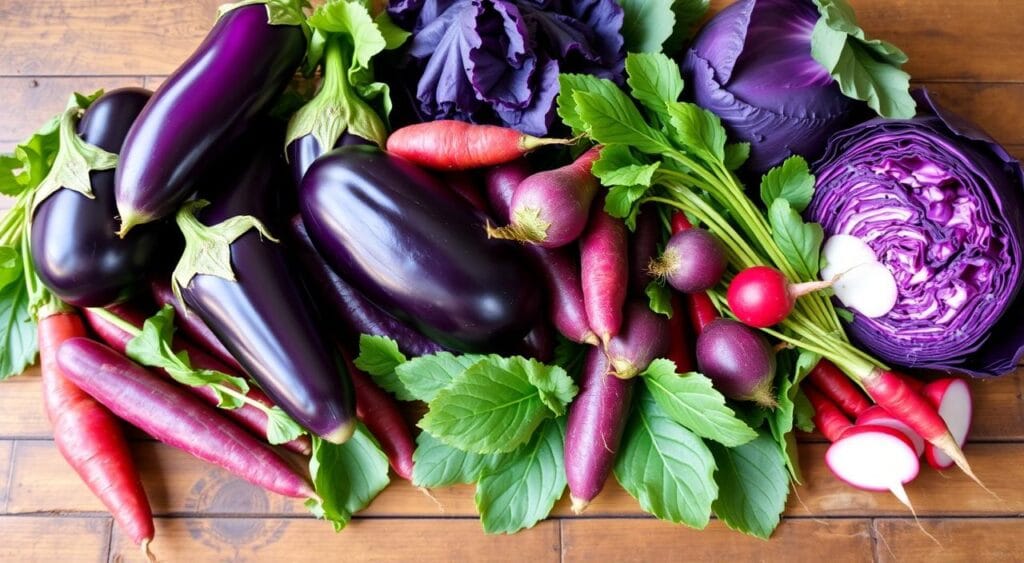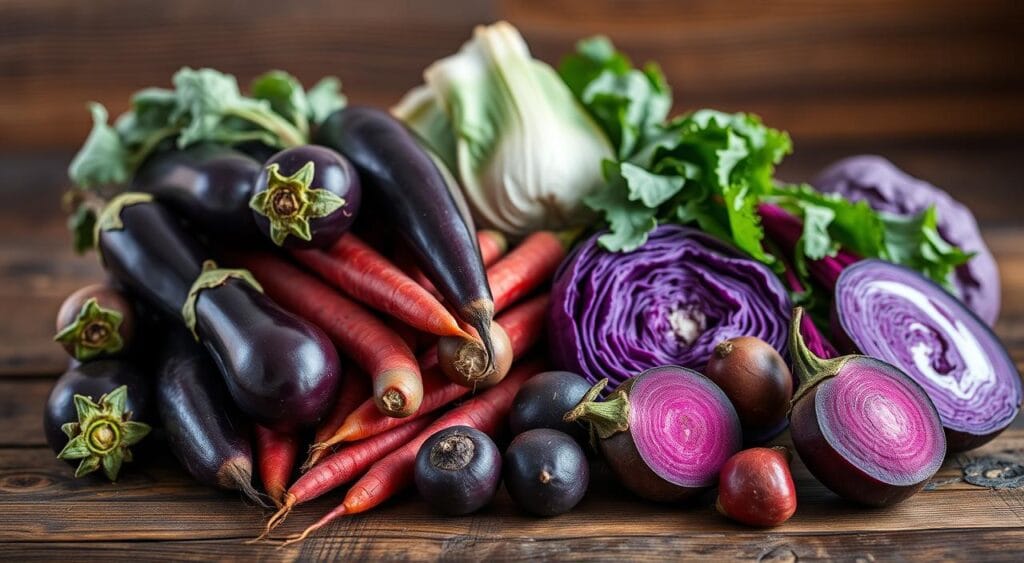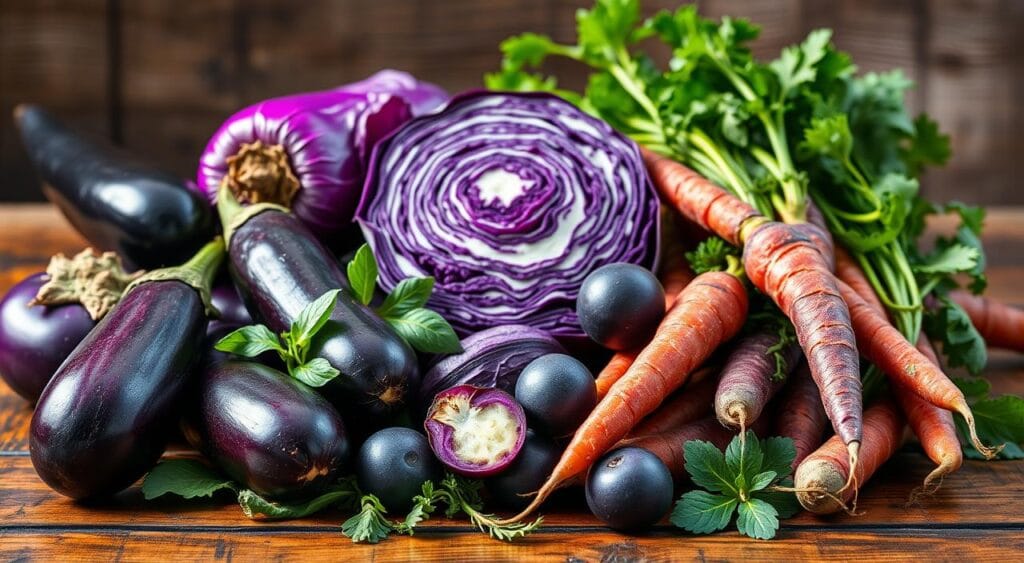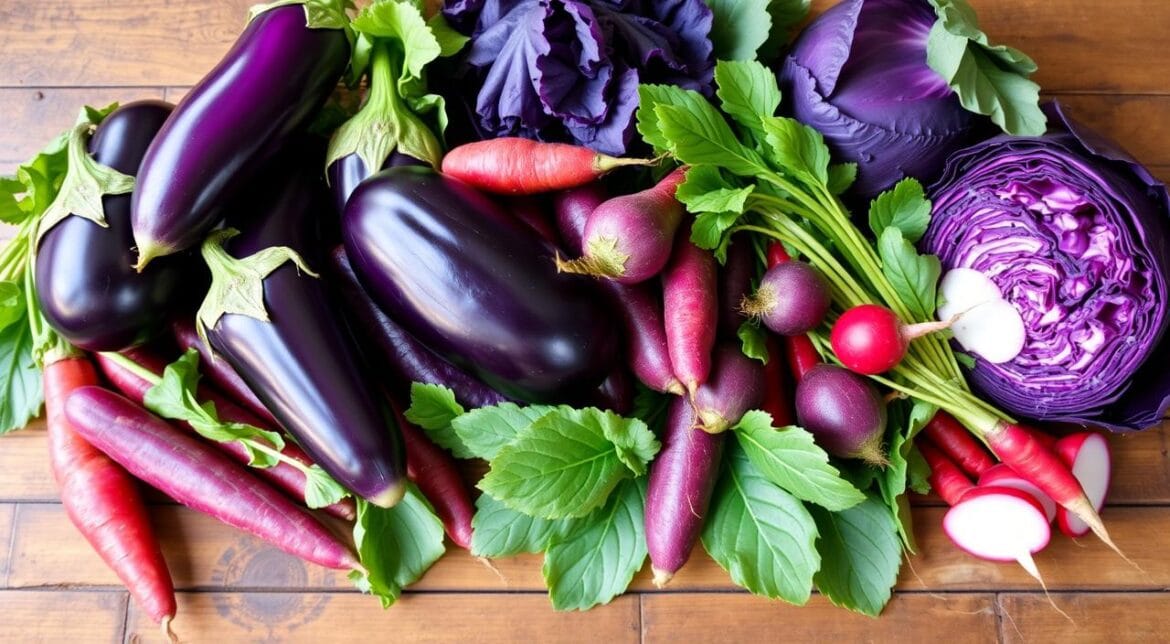Table of Contents
Benefits of Purple Vegetables :
Purple vegetables are becoming a big deal in health and nutrition. They offer a lot of benefits for your well-being. Their bright color and special nutrients make them more than just good-looking.
Exploring purple vegetables can help you add them to your daily meals. This way, you can enjoy all their benefits.

Key Takeaways
- Discover the science behind the vibrant purple pigmentation in vegetables
- Explore the diverse array of purple vegetable varieties and their distinct properties
- Learn about the impressive nutritional benefits of purple produce
- Understand the powerful antioxidant properties of purple foods
- Discover creative ways to incorporate purple vegetables into your meals
Understanding Purple Vegetables and Their Unique Properties
Discover the secrets of purple vegetables and their stunning colors. These vibrant hues come from powerful plant pigments called anthocyanins. These compounds not only make purple vegetables look amazing but also boost their nutritional value.
The Science Behind Purple Pigmentation
Anthocyanins create the purple, blue, and red colors in many fruits and veggies. These antioxidants help plants fight off stress and UV rays. Eating anthocyanins can also offer health benefits to us.
Common Types of Purple Vegetables
- Purple carrots
- Purple potatoes
- Eggplant
- Purple cabbage
- Purple cauliflower
- Purple asparagus
Nutritional Profile Overview
Purple vegetables are not only vibrant; they’re also rich in nutrients. They are abundant in vitamins A, C, and K, as well as fiber. Adding purple root vegetables and purple leaf vegetables to your meals can bring a lot of antioxidants and health benefits.
| Nutrient | Amount per 1 cup (raw) |
|---|---|
| Vitamin A | 690 IU |
| Vitamin C | 58 mg |
| Vitamin K | 42 mcg |
| Fiber | 3 g |

Benefits of Purple Vegetables for Your Health
Purple vegetables are not just pretty; they’re also full of nutrients. They have essential vitamins and compounds that boost your health.
These veggies are rich in antioxidants. The purple color comes from anthocyanins, which fight off harmful free radicals. This can reduce your risk of heart disease and certain types of cancer.
Purple vegetables also have anti-inflammatory properties. The anthocyanins in them can reduce inflammation. This is good for people with joint pain, arthritis, or inflammatory bowel conditions.
Research shows purple veggies might also improve brain function. Their antioxidants and anti-inflammatory effects protect the brain. This could help prevent cognitive decline as we age.
Some purple veggies, like purple potatoes, can help with weight management. They make you feel full, which can lead to a healthier diet and weight control.

“Incorporating a variety of colorful vegetables, including purple options, into your daily diet can be a simple yet effective way to boost your overall health and well-being.”
By adding purple vegetables to your meals, you can enjoy many health benefits. They make your diet more vibrant and nourishing.
Purple Root Vegetables: From Garden to Table
Explore the vibrant world of purple root vegetables. They go from the garden to your plate. These colorful gems, like purple carrots, potatoes, and yams, add beauty and nutrients to your meals.
Popular Purple Root Varieties
Discover the variety of purple root vegetables that can spice up your cooking:
- Purple Carrots: Sweeter and more intense than orange carrots, they keep a crunchy texture.
- Purple Potatoes: Their indigo color and creamy inside make them a great addition to your dishes.
- Purple Yams: Known as Okinawan sweet potatoes, they have a rich, almost purple flesh that’s both nutritious and tasty.
Storage and Preparation Tips
To keep your purple root vegetables fresh and colorful, follow these tips:
- Keep them in a cool, dark place like a root cellar or the fridge’s crisper drawer.
- Scrub them clean but don’t peel to keep the nutrient-rich skin.
- Cut them into even pieces for even cooking. Roasting, steaming, or boiling helps keep their antioxidants.
Cooking Methods to Preserve Nutrients
Choose cooking methods that keep your purple root vegetables’ nutrients and color:
- Roasting: Toss them in olive oil and roast at high heat to enhance sweetness.
- Steaming: Steaming is great for preserving nutrients and flavors.
- Boiling: Use little water and cook until tender to keep nutrients in.
Enjoy the beauty and health of purple root vegetables in your kitchen.
Antioxidant Power of Purple Foods
Purple vegetables and fruits are not just pretty to look at. They also offer many health benefits. The deep colors come from compounds called anthocyanins. These are strong antioxidants that fight off harmful free radicals in our bodies.
Antioxidants are key in fighting free radicals. These unstable molecules can harm cells and lead to aging and chronic diseases. Eating purple fruits and vegetables regularly can help keep you healthy.
Research shows that anthocyanins in purple foods may help in several ways. They can:
- Reduce inflammation
- Improve brain function and cognitive health
- Promote heart health by enhancing blood flow and reducing blood pressure.
- Protect against certain types of cancer
- Boost the immune system
The bright colors in purple vegetables are not just for looks. They also mean these foods are full of good stuff. Eating a variety of colorful foods, including purple ones, helps you get all the nutrients and antioxidants you need.
“The deeper the color of the fruit or vegetable, the more antioxidants it typically contains.”
So, when planning your meals, don’t forget to include purple benefits of purple vegetables. Your body will appreciate it!
Purple Leaf Vegetables: A Colorful Addition to Your Diet
Explore the world of purple leaf vegetables and see how they can make your meals pop. These greens, like deep purple kale and stunning purple cabbage, are not just pretty. They’re also packed with nutrients that are beneficial for your health.
Growing Your Own Purple Leafy Greens
Got a green thumb? Try growing your own purple leaf vegetables. They love well-drained soil and lots of sunlight. Plant the seeds or seedlings, and with a bit of care, you’ll have a garden full of these colorful greens.
Creative Ways to Include Purple Leaves in Meals
- Toss purple kale or purple cabbage into your favorite salads for a pop of color and extra nutrients.
- Sauté purple leaf vegetables with garlic and olive oil for an easy side dish.
- Blend purple leaves into smoothies or juices for a nutrient-dense boost.
- Use purple cabbage leaves as a colorful and flavorful wrap for your sandwich fillings.
- Incorporate purple leaf vegetables into stir-fries, pasta dishes, or grain-based bowls for a vibrant addition.
Adding purple leaf vegetables to your diet is a great way to make it more colorful and healthy. Whether you grow them yourself or buy them, these greens are a purple and white vegetable that should be on your plate.
Comparing Purple and White Vegetables: What’s the Difference?
The color of vegetables can greatly affect their nutritional value and health benefits. Let’s look at the differences between purple and white vegetables.
Potatoes are a great example. White potatoes are common, but purple potatoes have more antioxidants. This is because of anthocyanins, which are powerful plant compounds. They give purple potatoes their color and help protect against stress and inflammation.
| Nutrient | Purple Potatoes | White Potatoes |
|---|---|---|
| Antioxidants | Higher | Lower |
| Vitamin C | Comparable | Comparable |
| Potassium | Slightly higher | Slightly lower |
Other purple and white vegetable pairs, like cauliflower and purple cabbage, also show differences. Purple varieties often have more nutrients, including antioxidants, vitamins, and minerals.
Purple root vegetables are not just pretty. They also offer a variety of phytochemicals. These compounds are important for our health and well-being.
“Including a diverse array of colorful vegetables, such as purple and white varieties, allows you to benefit from a broader spectrum of nutrients and antioxidants.”
Choosing between purple and white vegetables depends on what you like and your nutritional needs. Eating a variety of colorful vegetables ensures you get all the important nutrients and compounds.
Incorporating Purple Vegetables into Your Daily Meals
Exploring purple vegetables can bring color and nutrients to your meals. These foods are not only tasty but also packed with antioxidants. Here are some ways to add them to your daily diet.
Easy Recipe Ideas
Adding purple vegetables to your meals is easy. Try roasting purple potatoes or carrots with olive oil and herbs. They make a tasty side dish. Purple leaf vegetables like kale or Swiss chard are great with garlic and lemon juice.
Meal Planning with Purple Produce
- Add purple cauliflower or eggplant to stir-fries, curries, or pasta for color and nutrition.
- Blend purple cabbage or beets into smoothies or juices for a vibrant drink.
- Roast a mix of purple fruits and vegetables like potatoes, onions, and Brussels sprouts for a sweet side.
Shopping and Selection Guide
When picking purple leaf vegetables and purple fruits and vegetables, choose vibrant, unblemished ones. Store them right, like keeping potatoes cool and dark, and greens in the fridge. With a bit of planning, you can make these foods a part of your daily meals.
Seasonal Guide to Purple Vegetables and Storage Tips
Adding purple vegetables to your meals is a great way to make them look and taste better. These colorful foods are not only beautiful but also good for you. Knowing when they’re in season and how to store them is key to enjoying them fully.
Seasonal Availability of Purple Veggies
The time when purple vegetables are available can change based on the type. Here’s a basic guide to when you can find them:
- Purple Root Vegetables: Look for purple carrots, potatoes, and radishes from fall to early spring.
- Purple Leaf Vegetables: Purple kale, cabbage, and lettuce are available all year. They’re at their best in spring and fall.
Storing Purple Vegetables for Optimal Freshness
Keeping purple vegetables fresh and colorful is important. Here are some tips for storing them:
- Keep purple root vegetables in a cool, dark spot like the fridge or a root cellar. This helps keep their color.
- Wrap purple leaf vegetables in a damp paper towel. Then, put them in the fridge’s crisper drawer. This keeps them crisp and fresh.
- Eat purple vegetables as soon as you can. This way, you get the best taste and health benefits.
By knowing when they’re in season and how to store them, you can enjoy purple root vegetables and purple leaf vegetables all year. This unlocks their full health and flavor potential for your meals.
Conclusion
Purple vegetables add color and nutrition to any meal. They are packed with antioxidants and vitamins. These foods are great for your health and taste.
Adding purple fruits and veggies to your diet is smart. They give you important nutrients like vitamin C and fiber. They also have anthocyanins, which fight diseases.
Keep trying new purple foods to improve your health. They make your meals tasty and colorful. Enjoy the benefits of purple veggies and explore new recipes.
FAQ
What are the benefits of incorporating purple vegetables into my diet?
Purple vegetables are full of antioxidants, vitamins, and minerals. They can help your heart, prevent cancer, and reduce inflammation. They also boost brain function and may help with weight management.
What are some common types of purple vegetables?
Popular purple veggies include eggplant, purple carrots, and purple potatoes. You’ll also find purple cauliflower, cabbage, and kale. These get their color from anthocyanins, which are antioxidants.
How do the nutritional profiles of purple and white vegetables differ?
Purple veggies have more antioxidants and vitamins than white ones. For example, purple potatoes have more anthocyanins, vitamin C, and potassium. Knowing these differences helps you get more nutrients in your diet.
What are some tips for storing and preparing purple vegetables?
To keep purple veggies fresh, store them in the fridge away from light. Use cooking methods like steaming, roasting, or sautéing to preserve nutrients. Avoid overcooking to keep their nutritional value high.
How can I incorporate more purple vegetables into my meals?
There are many ways to add purple veggies to your meals. Roast purple carrots or potatoes, or add purple cabbage to salads. Try sautéing purple kale or making purple sweet potato casserole or eggplant Parmesan.

